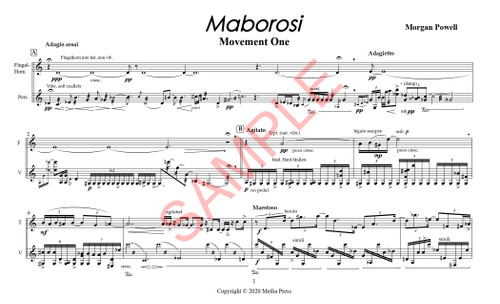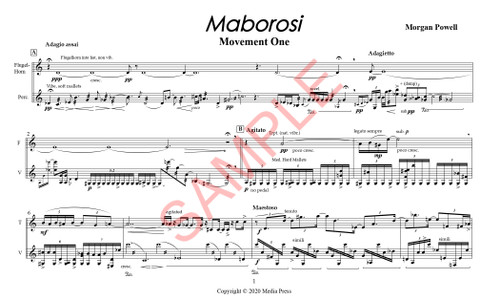For Bb trumpet, Bb clarinet and percussion (1 player), includes three scores. Fine Tuning, "chasing the elusive oneness," 1981 by Morgan Powell is a duet for Bb trumpet (top staff) and Bb clarinet (bottom staff) with ringing excursions in percussion. The piece was composed for Ray and David Sasaki and Michael Udow for a concert of Powell's music in New York City, 1981. The duet embodies two ideas: different routes to the same destination and two, finely tuned, are still two. premiere: 15 April 1981, New York City. duration: ca. 6 minutes
Print size: 11 x 17"
Review from Percussive Notes:
Although composed for a New York City premiere in 1981, “Fine Tuning” seems to take its artistic cues from the avant-garde circles of 1960’s Western Europe. Despite the relatively minimal forces involved, the piece nonetheless feels “operatic,” in that it adheres to the familiar back and forth between meditative “arias” in the wind parts and more propulsive “recitatives” in the percussion, with only a couple fleeting moments in which all three players can be heard at the same time. The wind parts are categorically lyrical, and trumpet players will enjoy the opportunity to use various mutes and other gadgets to produce different tone colors, but the percussion part (which, unlike the wind parts, is written exclusively in graphic notation) seems almost to belong to another work entirely. The graphic notation is not particularly revolutionary, and in fact seems fairly intuitive, but without any further explanation in the performance notes, composer Morgan Powell is throwing himself at the mercy of his performers. How wonderful to find a composer so trusting!
At its best, the piece could be easily used as a vehicle to showcase different aspects of all three performers’ virtuosity, be it the technical facility of the percussionist or the tone and color control of the wind players, but ultimately the success or failure of any performance will depend almost entirely on the maturity of the percussionist. With the right instrument selection and thoughtful realization of the score, the contrasting parts can indeed combine to form a powerfully effective musical result, but there is a danger in that an immature performer might take the graphic notation as free license to improvise with little forethought or preparation, and the resulting performance will undoubtedly devolve into something akin to different parts of a wind ensemble warming up at the same time on different materials.
I would recommend this piece to any mature, contemporary-music-minded college senior or graduate student in search of repertoire to perform with trumpet and clarinet friends. For that matter, since the parts are given in concert pitch, one could easily envision a percussion trio version of this piece, although some creative solutions (such as bowed notes and pitch-bending) might be required to capture the spirit of the work. I found “Fine Tuning” to be a very interesting piece with plenty of room for exploration, and that alone makes it worth checking out.
—Brian Graiser
Demo:







